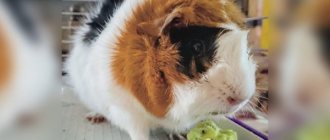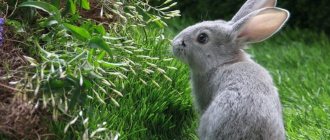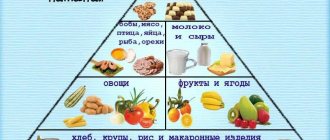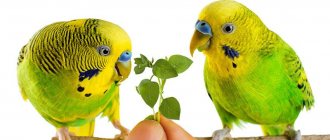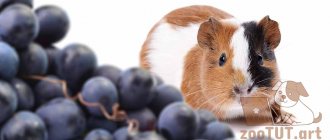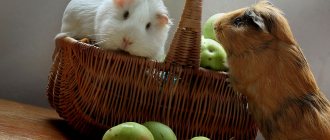What herb will benefit guinea pigs. What plants can be introduced into the diet of pets. Benefits for the body. What herbs are prohibited to give, what are the dangers. What herbs should be given fresh? How to dry grass correctly.
Grass is the main food for a guinea pig, so it is very important to know which plants benefit your pet’s body and which can be harmful and have a negative impact on health.
A variety of plants are rich in vitamins and microelements, and are the main sources of nutrients. Next, we will look in detail at which herbs should be included in your pets’ diet, and which ones are prohibited.
Benefits of herbs
To understand why grass and greenery are so important, you need to know that guinea pigs are herbivores. Their digestive system is adapted to digest coarse plant fibers. And so that the body does not malfunction, the diet should always contain fiber, which is found in grass and leaves.
Fruits and vegetables cannot replace hay, lush grass and leaves. Even if they exceed the nutrient content many times over, they will not provide the required amount of fiber.
Green feed
Not all green foods are created equal for pigs. Many novice breeders wonder whether guinea pigs can have one or another type of succulent green food.
The list of permitted green feeds is quite large and includes:
- Grass (field grass or meadow grass is suitable),
- Carrots (rich in vitamin C),
- Apples,
- Dill, parsley, lettuce,
- cauliflower,
- White cabbage leaves,
- curly chicory,
- Parsley,
- Cilantro,
- Celery,
- Spinach,
- Birch twigs,
- Green beans or peas,
- Any sweet pepper
- Brussels sprouts,
- Watermelons,
- fodder beet,
- Red beets along with tops,
- cucumbers,
- Dandelions,
- Garden sow thistle,
- Shepherd's purse
- Sowing peas,
- plantain leaves,
- Yarrow leaves,
- Coltsfoot
- Earthen pear
- Cobs and greens of young corn,
- Coriander.
In addition, guinea pigs can be given clover and alfalfa, vetch, lupins, sweet clover and winter rye or oats, and ryegrass.
What kind of grass can you give?
The list of acceptable herbs for guinea pigs is quite wide; pets will not suffer from a shortage.
All herbs should be collected from clean lawns and forests away from roads and industrial enterprises.
Dandelion
The leaves and roots of the plant are suitable for feeding the guinea pig. The leaves contain carotenoids and vitamins: C, groups B and P. The roots contain glucose and inulin. Dandelion helps improve blood circulation, gastrointestinal function, and increases appetite. It is better to give it fresh; it is permissible to prepare it in the form of hay for the winter. Only the green part of the plant is used as food; flowers should not be given to animals.
Plantain
A good remedy for normalizing blood glucose. Young leaves are added to your pet's diet - they are rich in potassium, contain carotene, enzymes and glycosides.
Clover
Ripe red and white clover plants are prepared for guinea pigs. Young grass can be given, but with caution, it can cause gastrointestinal upset.
You need to be careful when feeding a pregnant guinea pig; a large amount of clover in your pet's diet can cause a miscarriage.
Quinoa
Animals love this grass. But you don’t need to get carried away with it: quinoa contains acid, the excess of which leads to urolithiasis. It should be included in the diet in moderation.
Common borer
The grass is harmless to your pet and is given without fear throughout the season.
Chamomile
Chamomile is a natural antibiotic that helps cope with inflammation, relieves spasms, bloating, soothes and relieves pain. For gastrointestinal disorders, you can prepare a decoction of chamomile and feed it to your guinea pig.
Burdock
You can add burdock roots and leaves collected in spring and summer to your pet’s diet. Burdock is especially useful for diabetic animals due to its inulin content, which acts as a prebiotic, improving the functioning of the gastrointestinal tract.
Burdock has a laxative and diuretic effect. If the animal does not suffer from constipation, then this plant is introduced into the diet in small quantities.
Alfalfa
A nutritious plant for pregnant and lactating guinea pigs, as well as for growing young animals. Alfalfa contains a lot of calcium, which is why adult rodents should limit it.
Coltsfoot
In moderate quantities it will help with gastrointestinal problems and infectious diseases. Can be given as a decoction, or fresh or dried leaves. If given too much, coltsfoot can cause digestive upset.
Woodlice or chickweed
Relieves inflammation, normalizes blood pressure, and has moderate diuretic and choleretic properties. There are no contraindications to introducing woodlice into a guinea pig's diet, but it is recommended to offer it in moderation.
Common wormwood
It is well accepted by guinea pigs; fresh twigs can be given all summer, and hay can be stored for the winter. On the contrary, it is better to minimize bitter wormwood in the diet.
Sedge
This is a favorite treat for animals. And the most harmless thing: sedge can be given to guinea pigs in unlimited quantities and at any time of the year.
Wheatgrass
Like sedge, it is considered a favorite plant. It can be given fresh or made into hay.
Yarrow
Useful for kidney and urinary tract diseases, helps increase appetite. For prevention, it is recommended to include it in small quantities in the daily diet.
Nettle
To feed your guinea pig, it is better to use young nettle leaves before flowering. After flowering, the amount of nutrients decreases significantly. It is also better to collect leaves for hay before the plant matures. If it is not possible to collect nettles, you can use pharmaceutical preparations of leaves.
To prevent the nettle from burning your pet, it must be doused with boiling water before serving; the leaves will become softer and will not prick.
Mint
There are no contraindications for mint to be consumed by guinea pigs. It's more a matter of taste: some pets happily gobble up the fragrant leaves, others don't like it at all. It is recommended to include it in the diet in small quantities.
List of prohibited foods for guinea pigs
List of products that should not get into the animal’s feeder:
- raw potatoes and dishes made from them;
- any dairy products, including butter, kefir, yogurt, cottage cheese;
- marinades and smoked products;
- fresh cucumbers and tomatoes purchased out of season;
- any confectionery products, including sweets, cakes, marshmallows and chocolate;
- raw or cooked meat and fish;
- eggs in any form;
- sorrel and rhubarb;
- green onions, onions, garlic and mustard;
- mushrooms in any form;
- horseradish (leaves and roots);
- radishes and radishes;
- salt, sugar, honey;
- coffee, sweetened tea;
- bread and pasta.
It is dangerous to give branches of some trees and shrubs, for example, oak, rowan, pine, spruce, and prickly gooseberry. To avoid mistakes, it is better to offer shoots of apple, pear, currant, cherry, hawthorn and raspberry as twig food. You need to especially carefully monitor your pig's diet after giving birth. If the female comes across a toxic product, the babies may be left without a nursing mother.
You should not conduct dangerous experiments by offering animals exotic products from the supermarket. It must be remembered that the nutrition of rodents should be as close as possible to natural conditions. In their homeland in South America, guinea pigs feed exclusively on leaves, roots, fruits and branches of trees, meadow grasses, stems, leaves and inflorescences of shrubs. In the wild, they eat very little to keep themselves in good physical shape. Otherwise, they will become easy prey for predators.
Pigs are herbivores, so in nature they do not eat food of animal origin. They cannot eat it at home either. Therefore, it is better not to offer animals milk and dairy products (cheese, cottage cheese, butter), meat, fish, poultry and eggs. If you need to feed the babies yourself, it is better to use a dairy-free formula for babies.
What kind of greens can you give?
To diversify a guinea pig's diet, it includes not only healthy herbs, but also greens from the garden.
Lettuce leaves
Lettuce contains potassium, calcium and iron, which are important for keeping your pet healthy. At the same time, you should not give a lot of lettuce to guinea pigs with diabetes, as the leaves contain a lot of sugar.
Fresh salad is on the menu all year round. Greens grow quickly and are easy to grow on a windowsill.
Cilantro
Despite its strong aroma, cilantro is especially popular with guinea pigs. It does not contain harmful substances, so you can give it to your pet in unlimited quantities.
Green onions
It is permissible to feed only in small quantities. Green onions contain phytoncides that can irritate the stomach walls.
Spinach
A source of proteins and vitamins, it also contains minerals such as calcium, phosphorus, iron salts, potassium. Spinach is suitable for feeding guinea pigs in any form: fresh, frozen or dried. But only young leaves can be used.
Celery
One of the products that contains little sugar. This allows you to safely feed celery to diabetic guinea pigs. Both roots and leaves are beneficial for pets.
Parsley
Useful for young offspring and during the molting period. It is also recommended as an immunostimulant after illnesses.
Dill
Dill should be administered during pregnancy and lactation. It improves the nutritional properties of milk and helps increase its quantity.
Arugula
Acceptable in small quantities, but it should not be the first food for a guinea pig. Arugula contains mustard oil and accumulates a lot of nitrates in its leaves, which can be dangerous for young and pregnant pets.
Iceberg lettuce
Salad in large quantities can cause bloating. It is better to reduce the addition of greens to the diet to a minimum.
Is it possible to give raspberry leaves?
Unlike the berries themselves, raspberry leaves and branches do not contain sugar, which is so harmful to the body, but at the same time, they contain a large number of useful substances that will be beneficial to the pet’s health.
You can give them daily, the only thing you need to remember is to wash them thoroughly before giving them to your guinea pig.
Also remember that leaves should not be picked near highways, factories, or in swampy areas; such treats can harm your pet.
Feeding rules
To provide your pet with a balanced diet, you need to familiarize yourself with the rules and regulations for feeding guinea pigs.
- It is advisable to feed your pet at the same time. This way he will develop a routine.
- Feed should be given little by little and fresh each time. All leftovers from the previous meal should be thrown away. It is permissible to leave only hay in the cage.
- The diet should not contain limp greens, vegetables and fruits.
- Hay, grass and greens are the basis of nutrition; guinea pigs should always have them.
- Greens, grass, vegetables and fruits should be thoroughly washed. There is no need to peel fruits and vegetables.
- Water for guinea pigs should always be clean and should be changed once a day.
- In order for guinea pigs to grind their teeth, they need to be given tree branches: willow, ash, alder, apple, pear, linden, birch.
Harvesting hay
Hay can be harvested from early spring until late autumn. Plants are dried under a canopy, out of direct sunlight.
In apartment conditions, an electric dryer will help out, with which you can prepare several kilograms of hay for a pig in less than 3 hours. If this is not possible, spread the grass in a thin layer on clean paper and leave to dry in a dry, ventilated place.
Freshly dried hay retains its nutritional value for up to 5 months. Dry grass smells pleasant, does not crumble into powder in your hands, and most plants retain their green color when dried.
If the hay has an unpleasant odor, it is strictly forbidden to give it to the rodent.
What grass and greens are prohibited
Plants that should absolutely not be given to guinea pigs:
- Rhubarb. Contains a lot of oxalic acid, which has a bad effect on kidney function. Because of this, stones can form in them and inflammatory processes can develop.
- Spurge. All types of milkweed are poisonous. After eating such complementary food, a guinea pig may experience convulsions, cardiac arrest, and the bitterness of milkweed juice leads to inflammation of the mucous membranes.
- Sorrel. Contains a lot of acid, which irritates the mucous membranes and stomach walls and can cause kidney disease.
- Avran. Causes stool upset and vomiting, leading to inflammation of the gastrointestinal tract.
- Winter meadow. It hits the blood vessels. Guinea pigs experience lethargy, heavy salivation, loose stools with blood, bloating, and a drop in temperature. If a large amount of grass is consumed, the animal dies.
- Whitewing. When eating berries, profuse salivation begins, tachycardia appears, and the animal begins to behave restlessly.
- Hemlock. After consuming the grass, the guinea pig's breathing and heart rate increase, convulsions and numbness in the limbs appear, and the temperature decreases.
- Fighter, aconite and other buttercups. The poison of these plants causes diarrhea, salivation, decreased blood pressure and body temperature. The animal begins to experience shortness of breath, and its behavior becomes violent.
- Celandine. Leads to burns of the mucous membranes, which is accompanied by weakness, gastrointestinal upset, and bloating.
- Cicuta. A plant that leads to rapid paralysis and death of the animal. When it gets into the animal's food, severe salivation, bloating and diarrhea begin, breathing and pulse quicken.
- Hellebore. Leads to convulsions, tremors, causes diarrhea and drooling. Breathing disturbances are observed.
- Wild mustard. Essential oils of the plant cause burns to the mucous membranes and respiratory organs, and affect the mucous membranes of the gastrointestinal tract.
- Bitter radish. Essential oils are also dangerous for animals. They burn the oral cavity, nasopharynx and gastrointestinal tract.
- Datura causes paralysis of the heart and legs.
- Digitalis. Leads to inflammation of the gastrointestinal tract, which is accompanied by diarrhea, bloating and vomiting. Shortness of breath, tachycardia and convulsions may occur.
- Cornflowers can cause colic, diarrhea and vomiting. When eating a large amount, paralysis occurs.
Grass and greens must be included in the daily diet of guinea pigs. Not so much because of the content of useful microelements in them, but because of the coarse fiber, which is the basis of nutrition for all herbivores. But not every herb is harmless to animals; some plants can cause serious illness or even death of an animal. When collecting grass and making hay yourself, it is important to study each plant so that noxious weeds do not get into the food.
Poisonous plants
There are many plants that are poisonous to your pet and can cause death. You should not give your pig celandine, arum, henbane, rhubarb, fern, nightshade, or horse sorrel. The flowers, leaves and tubers of lily, hyacinth, lily of the valley, and narcissus are poisonous. You should not feed your pet white acacia, sorrel, broom, ivy and broom.
Not every tree or shrub is suitable for an animal. They should not be fed branches and roots of dogwood, juniper and thuja. Hellebore, oleander and belladonna are extremely dangerous for rodents. A pig can become poisoned by tasting euphorbia, aloe, or geranium.
